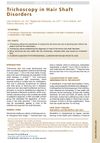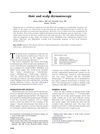The Trichoscopic Features of Hair Shaft Anomalies Induced by Epidermal Growth Factor Receptor Inhibitors: A Case Series
March 2020
in “
Journal of the American Academy of Dermatology
”
TLDR EGFR inhibitors often cause dry, brittle hair and eyebrow/eyelash changes.
This case series evaluated the trichoscopic features of hair shaft anomalies in 23 patients treated with epidermal growth factor receptor inhibitors (EGFRIs) at a tertiary oncodermatology clinic between 2015 and 2017. The study found that 78% of patients exhibited dry, lusterless, coarse, kinky, brittle scalp hair, and 74% had trichomegaly of the eyebrows/eyelashes. Trichoscopic findings included pili torti in 87% of scalp hair cases, and asymmetric hyperpigmented fusiform widening in 13% of scalp hair cases. Dermoscopic findings included scale, whitish erythematous structureless areas, and branching vessels. The study highlighted the lack of trichoscopic-histologic correlation and baseline examination as limitations.








